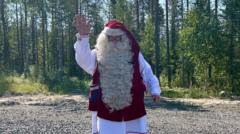Is Santa Sweating in Lapland's Record Heatwave?

Understanding the Impact of Climate Change on Lapland's Unusual Summer Heatwave
This summer, the enchanting land of Lapland, famously known as Santa’s winter wonderland, is experiencing an unprecedented heatwave. With temperatures soaring to record highs of around 30°C, even Santa himself is adjusting his routine to cope with the sweltering weather. The heatwave, which has gripped northern Finland for an extended period, is a stark reminder of the pressing issue of climate change. As we delve into the implications of this phenomenon, we’ll explore how it affects the region’s wildlife, tourism, and the very essence of what makes Lapland so special.
The Unprecedented Heatwave: A Brief Overview
Lapland is typically characterized by its cold weather, especially during the summer months. However, the recent heatwave has seen temperatures soar for an astonishing 15 consecutive days, marking a significant departure from the norm. According to the Finnish Meteorological Institute, a heatwave in Finland is defined as a period exceeding 25°C for at least three consecutive days. This year’s weather has shattered previous records, with temperatures reaching as high as 31.7°C in locations like Ylitornio and Sodankylä.
Climate Change: The Underlying Cause
While meteorologists emphasize that this specific heatwave may not be directly caused by climate change, they acknowledge its influence. Climate change is accelerating the warming of the Arctic, with the region experiencing temperature increases at a rate four to five times faster than the global average. This is leading to more frequent and intense heatwaves, raising alarm among scientists and environmentalists alike.
Consequences for Wildlife and Ecosystems
The effects of the heatwave are not limited to humans; they extend to the wildlife that calls Lapland home, particularly the iconic reindeer. With rising temperatures, reindeer are facing challenges such as increased mosquito populations, which thrive in warmer conditions. Seeking relief, these animals are moving toward populated areas, including roads and villages, which can lead to dangerous encounters with humans and vehicles.
Tourism and Visitor Experience
Traditionally, Lapland has been a sought-after tourist destination, especially during the winter months when snow blankets the landscape. However, the current heatwave is leaving visitors bewildered. Tourists arriving with expectations of cool, crisp weather are instead greeted with scorching temperatures. Many, like Silvia from Prague, find themselves ill-prepared, having packed summer clothing instead of the winter attire they anticipated needing. This shift in climate is not only impacting the experience of tourists but also the local economy that relies heavily on winter tourism.
Santa's Dilemma: Adapting to New Norms
Even Santa Claus, the beloved figure synonymous with Christmas, is feeling the effects of the heatwave. His traditional red costume, designed for cold winter nights, becomes a burden in soaring temperatures. Santa now finds himself spending most of his day indoors, venturing out only in the cooler evenings to enjoy a swim in the lake. His concerns reflect a broader anxiety over the changing climate: "Of course, a hot summer can be very nice for some, but I prefer cold and snow," he admits.
Future Implications for Lapland
The heatwave has sparked conversations about the future of Lapland’s winters. Elina, an elf working in Santa's post office, expresses concern over whether heatwaves will become the new normal. This sentiment is echoed by many locals who have witnessed the gradual transformation of their environment. With climate change likely to bring about more extreme weather patterns, including prolonged heatwaves, the future of Lapland’s iconic winter landscape hangs in the balance.
Adaptation Strategies
As Lapland faces the reality of a warming climate, preparation and adaptation become essential. Here are some strategies that can be considered to mitigate the impacts of heatwaves:
- Infrastructure Improvements: Building shaded areas and barns for livestock can help protect reindeer from extreme heat.
- Tourism Management: Adjusting marketing strategies to attract summer visitors while promoting winter activities can help balance tourist expectations.
- Community Awareness: Engaging local communities in climate education can enhance resilience and foster proactive measures against climate change.
The Role of Climate Change Education
Education plays a pivotal role in addressing climate change. Understanding the science behind climate fluctuations can empower individuals and communities to make informed decisions. Schools, local governments, and organizations should prioritize climate education to raise awareness of the urgent need for action. By fostering a culture of sustainability, Lapland can cultivate a community that is better equipped to handle the challenges posed by climate change.
FAQs about Lapland's Heatwave and Climate Change
What constitutes a heatwave in Finland?
A heatwave in Finland is defined as a period of at least three consecutive days where the daily maximum temperature exceeds 25°C.
How is climate change affecting Lapland's wildlife?
Climate change is causing shifts in weather patterns, leading to increased temperatures and altered habitats. This affects wildlife, such as reindeer, which are experiencing challenges from rising mosquito populations and changing foraging conditions.
What can tourists expect when visiting Lapland during a heatwave?
Tourists visiting Lapland during a heatwave can expect much warmer temperatures than the typical cool climate. It's advisable to pack accordingly, as many visitors are caught off guard by the heat.
What are some long-term solutions to combat climate change in Lapland?
Long-term solutions include implementing sustainable practices, enhancing community awareness regarding climate change, and investing in infrastructure that adapts to changing weather patterns.
Is it possible for Lapland to return to its traditional winter climate?
While it is challenging to revert back to past climate conditions, concerted global efforts to combat climate change could help stabilize temperatures and preserve the unique winter environment of Lapland.
As we witness the unfolding impacts of climate change, it’s crucial to reflect on our responsibilities to the environment. How can we contribute to preserving the beauty and integrity of places like Lapland for future generations? #ClimateChange #Lapland #Sustainability
Published: 2025-07-25 00:36:08 | Category: world



